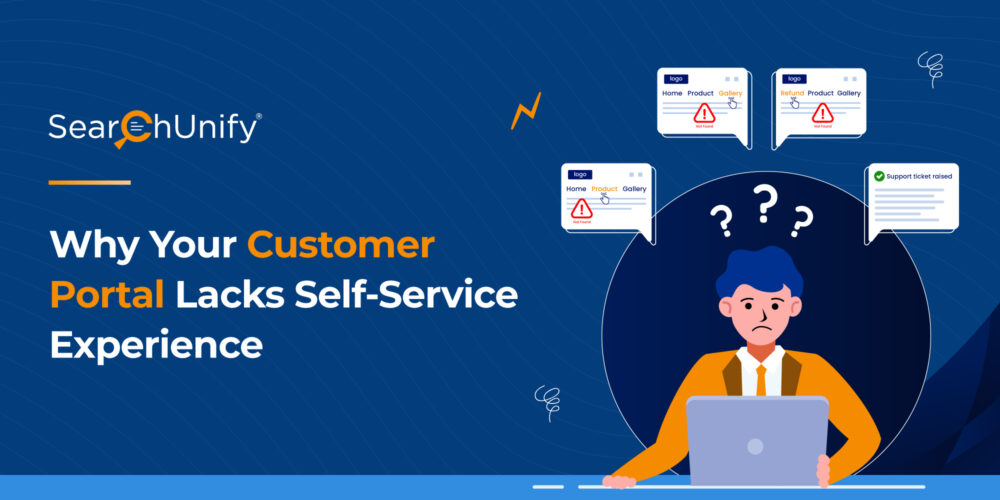
Gartner indicates that 44% of customers visit an organization’s website first before contacting support agents.
In this digital era, customers are not willing to call support and are stuck with endless phone menus. Instead, they love it when an organization values their time and provides an exceptional self-service experience.
As the customers’ needs evolve, the self-service portals have become the first place they visit to solve their queries. However, these portals can be a double-edged sword. They have the ability to empower customers to find relevant information. But at the same time, a poorly designed portal can leave customers frustrated and dissatisfied.
Let’s delve into the reasons why your support portal hampers your customer self-service experience.
5 Reasons Your Support Portal Lacks the Customer Self-Service Experience
Like all glitter is not gold, all support portals are not designed equally. Therefore, many organizations hit roadblocks in delivering great self-service because of poorly designed portals.
Here are the five reasons you should know why you should revamp your customer support portal to deliver a top-notch self-service experience.

1. Poor User Interface (UI): A Maze of Confusion
A cluttered library with no signs—a bad user interface looks like this. It has confusing navigation, hidden menus, poor search functionality, missing facets, and many more. It becomes challenging for customers to find simple answers in an overwhelming support interface.
Picture this: a customer seeks information about the return policy of the product they purchased and visit your support portal. But boom! Finding a simple answer feels like a treasure hunt. After spending precious time on a poor UI, the customer is left with no choice but to raise a support ticket. It not only increases support costs but also erodes customer satisfaction and retention.
2. Inadequate Search Functionality: Lost in the Information Abyss
Customers want easy access to information, but inadequate search functionality throws them into a frustrating information abyss. For instance, information about refund policies exists on the portal, but the search function delivers irrelevant or wrong information, undermining the purpose of self-service.
Additionally, a mediocre search experience erodes customers’ relationship with the brand, when only recognizing exact keywords and offering no help with synonyms or variations. The clunky search functionality even raises questions about the credibility of the support portal.
3. Outdated or Incomplete Content: A Knowledge Base Graveyard
Suppose your support portal UI and search functionality are in place, but users are still turning away. Wondering why?
This can happen due to a graveyard of outdated or incomplete information. Customers look for the latest information to resolve their issues, but offering outdated content leaves them feeling like their time is wasted.content.
Did you know that 80% of customers are more likely to switch to a competitor after one bad customer experience?
4. No Personalization : A One-Size-Fits-All Nightmare
As the saying goes, “Different strokes for different folks.” This applies especially in the customer support industry. Customers appreciate it when companies understand and value their feelings.
Without personalization, support portals fall short. A search that ignores user preferences, past interactions, and purchase history churns out generic and impersonal results, diminishing the customer self-service experience.
5. Limited Integration with Other Channels: A Siloed Support Experience
Limited integration with other channels, such as chat and email creates a siloed support experience. Customers expect a seamless experience through all touchpoints.
In case, you have a customer portal without an omnichannel approach, customers may have a jumbled and frustrated experience.
Imagine a customer seeking a solution to a simple problem through your self-service portal. But it requires information dispersed across different channels—email threads and past online chats. Without a seamless connection between these channels, your self-service portal becomes a dead end and sabotages their experience.
How Does It Impact Support Organizations?
Happy customers, happy business!
However, if your customers encounter challenges, your business will face consequences too. An outdated support portal has a prominent effect on support organizations.

1. Higher Ticket Volume: A Frustration Funnel
When customers can’t find the answer on their own, they turn to support agents and inevitably resort to submitting tickets. With the high surge in ticket volume, support agents get stuck with simple and repetitive issues, leading to longer resolution times that make customers furious.
Additionally, it prevents support agents from handling complex issues that might need their attention. Furthermore, they feel overwhelmed, which can quickly diminish their morale.
2. Increased Support Costs: A Drain on Resources
The high influx of tickets means you require more support agents, which directly burdens your resources. Hiring additional staff translates to increased payroll costs, not just for salaries but also for training them on your products and processes.
Additionally, existing agents might feel overworked, leading to burnout and potential turnover.
3. No Proactive Strategies: Flying Blind with Customer Issues
If your support portal fails to capture valuable customer data, it’s futile. You won’t gain insights into what information customers are searching for or what challenges they encounter.
Additionally, recurring issues will remain hidden. Customers will continue to face the same problems, leading to a poor self-service experience and a negative brand reputation.
Furthermore, without data-driven actionable insights about customer needs and behavior, your support strategy remains dormant, impeding innovation and improvement.
Automation Anywhere, a leading US-based cloud automation company, is one of the pivotal examples that crushed all these challenges and was honored with the TSIA Star Award and the ASP Award for “Best Support Website.”
By leveraging cognitive technology and innovative strategies, they achieved impeccable results in a brief duration, thereby driving a superior customer support experience.
Curious to know about their winning formula?
Attend our exclusive webinar featuring industry experts and learn how to enhance your customer service portal performance and deliver a best-in-class self-service experience.










